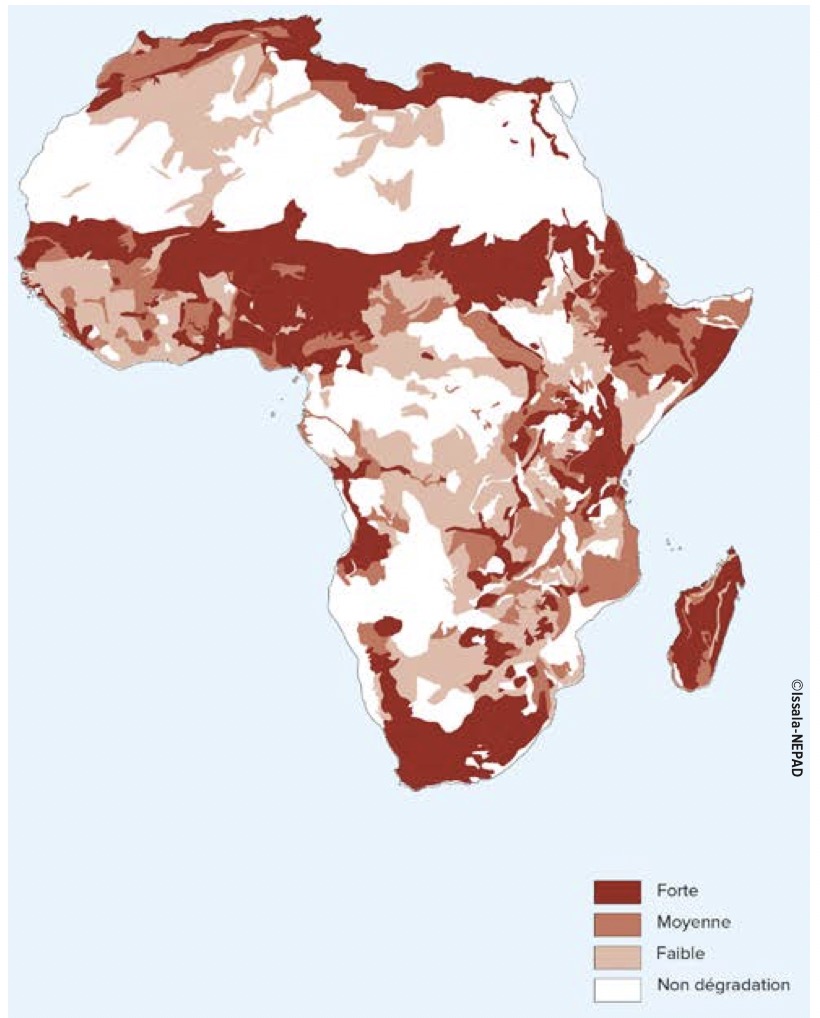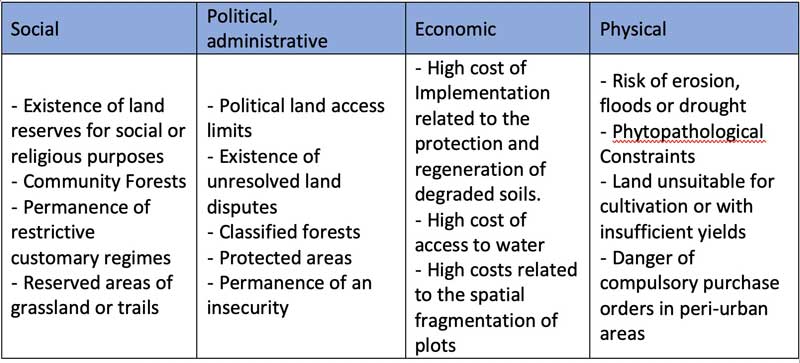The available and the degraded
In the dominant argument on “Empty Africa”, ecological constraints are always under-estimated, despite the fact that they significantly reduce the scope of availability. Here we find the distinction between availabilities and sustainabilities.
The combined effects of agricultural activities and climate change have accelerated the degradation of agricultural land grown both for arable land and pastures (Prăvălie, 2016)[1]. Soil degradation, as observed by remote sensing and satellite imagery, is greater in Africa than in the rest of the world (ELD-UNEP, 2015; Riegel et al , 2019). A significant proportion of available land is subject to serious ecological vulnerabilities: losses by erosion, salinization of soils, leaching of nutrients, accelerated mineralization, export of plant biomass, risk of invasion by predators, recurring plant diseases (Chaoran and Restuccia, 2018). Organic matter rates are often very low. In arid and semi-arid regions, the loss of the organic soil matter (MOS) and the conversion of the rare wetlands into arable land accelerate the acidification of the environment and desertification; and the rising temperatures leverages the speed of carbon mineralization in the soil (Guedegbe et al ., 2018). For their part, watered regions, which account for approximately 58% of the area cultivated in Africa, does not fare much better, even if the issue of soil degradation is not quite the same: the significant rainfall lin these areas cause floods, especially when the soil has a low plant cover. The resulting water erosion mainly concerns central Africa where the index of annual Tillage erosivity is very high (Panagos et al ., 2017).
Magnitude of soil degradation

Source NEPAD, 2013
Agricultural practices are not always optimum from the agronomic and ecological point of view (Le Moël et al, 2018). The major causes of land degradation include inadequate agricultural and forestry practices (too frequent ploughing, poor management of irrigation or phytosanitary treatments, overgrazing, excessive levies of forest products, uncontrolled bush fires). The absence or limited use of fertilizers causes a severe depletion of nutrients in the soil. The balance of nutrients is negative, with more than 4 times more nutrients exported by the product of the crops than those made in the form of manure and fertilizer (Guedegbe et al. , 2018; FAO, 2019).
In total, more than half of the area available for agriculture in the African continent would be affected by these processes of land degradation, thereby very seriously penalizing yields (OECD-SWAC, 2013; eld-UNEP, 2015; IFAD, 2019). This means that the actual availabilities still unexploited, and likely to be so in conditions which are sustainable for the environment (in preserving the forests, prairies, and habitats with ecological value) and with higher returns to an acceptable minimum, for cultures of at least one of the following products: wheat, corn, cassava, cotton, peanuts, cocoa, coffee, tea, palm oil, soy beans, rapeseed, fruits, vegetables, sugar, cut flowers and agrofuels, would be approximately of the order 50 million ha. This corresponds to the total large-scale land acquisitions by foreign investors between 2000 and 2018.
The available and uses
The available exploitable is therefore not likely to be exploited. The high value implementation constraints may be applicable for reasons other than agronomic ones. They are noticeable on a map drawn from a geospatial observation, as fine as it is. Here we find another distinction between sustainabilities and suitabilities. The lands have a social function. To understand it, we must perceive the “inner” realities of African agrarian practices and and the history of the land environment. However, the previous data incorporate without distinction land in summer fallow, i.e. Temporarily “rested” from production, as well as land used by the populations for their survival (collection, harvesting of wood for heating, hunting), community forests or even of areas reserved for ancestral rites which must clearly be excluded, failing which the general ecosystem of the territories concerned could be put at risk..
The above factors further reduce the areas newly usable for agricultural activities. And that doesn’t event include social and legal constraints[1]. It is estimated that in sub-Saharan Africa, less than 5 per cent of the land is registered in land registers or officially recognized by certificates or real estate titles. The rest may seem “free”, but without being so. Non-use for economic purposes or observed under-use does not mean full availability. “Vacant” is a quirk of legal language because this means in reality “populated but by occupants without titles”. Vacant is a definition for external use: “When there is talk of idle land, literally the land lazy or idle, nothing is done other than to stigmatize a mode of occupation of the land to better justify appropriation” (Chouquer, 2012, p. 8).
Outside the Sahara, in the heart of the Congolese basin and in protected areas of Kenya, Tanzania and Southern Africa, there are in reality virtually no rights-free areas in Africa, even in areas apparently available in large arid zones (Boone, 2013). As elsewhere, in Asia in particular, they are virtually always subject to rights and specific uses, originally established around the lineage, via successive land clearances by descendants. They now include useful or sterile land, and cultivated or fallow land. They result in very complex situations on the ground (Diop, 2016). Complex does not necessarily mean without order. On the contrary, a precise distribution of the functions of the land is established in which farmers still often refer to ensure their security in land tenure and food.
Legacy uses, entrenched in customary and unknown ancestral rights in agricultural statistics as on maps, but still widely used in African country areas, are essential to the reproduction of the family economy, in arid areas and in the wetlands. As soil availability is linked to the type of agreement between practices and social standards, it is therefore a concept which is variable both in time and space, but it also depends on the status of those concerned (men, women, old, young, natives or outsiders) and institutions (state, public communities, private sector, communities,…).
Table 2. Summary of constraints for the actual release of agricultural land

The demographic pressure also plays a role. A large part of the rural population now live in more densely populated areas (Yeboah and al, 2018). “Land is becoming less and less available and plots are more and more small and fragmented. In addition, parents live longer and continue to cultivate their land for longer. Young people who want to cultivate can work their parents’ land, thus delaying their transition to independence and their enhanced decision-making authority, or, if their finance and the local rental market allow, they can rent the land. If they rent, the problems of quality of the land and security of tenure are becoming a concern” (IFAD, 2019, p.23).
Faced with this set of constraints, two options are open to conquer and expand the untapped potential. 1/ move back the physical boundaries (extensification); 2/ alleviate the customary normative framework (commercialisation).



